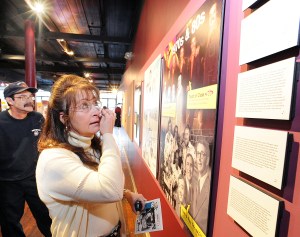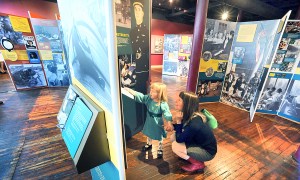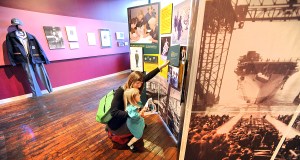LEWISTON — Housed in the former Bates Mill textile factory, Museum L-A was a fitting setting for a national historical survey of U.S. labor that opened here Friday.
“The Way We Worked” is a traveling multimedia exhibit that features Americans on the job since 1857.
The local museum is the only venue where visitors will find the traveling Smithsonian exhibit in Maine or New Hampshire.
The exhibit features standing panels printed with text and photographs in the center of the exhibit space. Artifacts, such as workers’ headgear, are attached to the panels along with audio, video and other interactive components, such as flip cards.
The exhibit includes five sections: where and how Americans worked at their jobs and what they wore, as well as labor conflicts and the dangers and unhealthy environments of some vocations.
“Every time we get an exhibit, we try to incorporate something local because we were part of the American scene,” said Rachel Desgrosseilliers, executive director and exhibit curator at the museum.
She pointed to photos and text of Lewiston businesses hanging on the museum’s walls and the uniforms and tools of various trades propped up around the perimeter of the large room.
A 100-year-old typewriter used by a local judge who typed up briefs on it sits on a pedestal.
“This was his new technology,” Desgrosseilliers said, explaining that the prominent judge had to write his briefs by hand before the advent of the typewriter.
On Friday, a museum volunteer roamed the space, taking down the stories of visitors.
“So, that shows you how far technology has come,” Desgrosseilliers said.
On another pedestal sat a vintage adding machine from Androscoggin Bank, which was created a century ago for millworkers to deposit their wages, she said.
Other local exhibits include archival photos of a local radio station studio and a local daily newspaper’s old-style presses.
An enlarged photo shows a 1937 shoe strike in Lewiston with the National Guard readying its rifles.
Some of the photos come from the museum’s archives; others were loaned by local businesses. All research was done by staff, Desgrosseilliers said.
“Music was huge” in the Twin Cities, she said.
Maureen Aube pointed to a photo of her father, Ray Pinette, a Lewiston keyboard player and singer who led a quartet and, later, a trio. He worked as a mortician, then as a printer to supplement his income as a musician, Aube said.
The local exhibit also offered a wall where adults could post photos of themselves working and children could post photos of their parents and grandparents at work.
Desgrosseilliers said she was approached by Historic New England, a nonprofit group that features historical buildings and artifacts, to host the Smithsonian exhibit. She decided the museum in the former mill was a perfect fit.
The local and national exhibits will be on display until May 4.
Roger and Marti Chabot of Auburn studied a photo of a millworker stoking the furnaces. “It’s exciting to see how we progressed,” she said.
“It’s amazing to see how hard they worked, and the conditions,” he said.
“It just boggles the mind,” Marti said.
Roger Chabot remembers his own job, filling vending machines at the Bates Mill in the early 1980s.
He said the smell of the place is the same 30 years later.





Comments are no longer available on this story